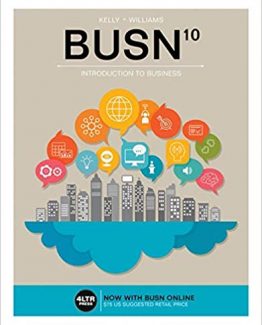Marketing Management 16th GLOBAL Edition by Philip Kotler, ISBN-13: 978-1292404813
[PDF eBook eTextbook]
- Publisher: Pearson; 16th edition (November 24, 2021)
- Language: English
- 607 pages
- ISBN-10: 1292404817
- ISBN-13: 978-1292404813
For undergraduate and graduate courses in marketing management.
Table of Contents:
Marketing Management
Brief Contents
Contents
Preface
What’s New in the 16th Edition
Solving Learning and Teaching Challenges
Acknowledgments
About the Authors
Marketing Management
Part 1 Fundamentals of Marketing Management
Chapter 1 Defining Marketing for the New Realities
Learning Objectives
The Scope of Marketing
What is Marketing?
What is Marketed?
The Marketing Exchange
The New Marketing Realities
The Four Major Market Forces
Technology
Globalization
Physical Environment
Social Responsibility
The Three Key Marketing Outcomes
New Consumer Capabilities
New Company Capabilities
New Competitive Environment
The Concept of Holistic Marketing
Relationship Marketing
Integrated Marketing
Internal Marketing
Performance Marketing
The Role of Marketing in the Organization
Organizing and Managing the Marketing Department
Organizing the Marketing Department
Functional Organization
Geographic Organization
Product or Brand Organization
Market Organization
Matrix Organization
Managing the Marketing Department
The Role of the CEO and CMO
Relationships with Other Departments
Building a Customer-Oriented Organization
Summary
Chapter 2 Marketing Planning and Management
Learning Objectives
Corporate and Business Unit Planning and Management
Defining the Corporate Mission
Building the Corporate Culture
Defining Strategic Business Units
Allocating Resources Across Business Units
Developing Market Offerings
Developing the Marketing Strategy
Identifying the Target Market
Developing a Value Proposition
Designing the Marketing Tactics
The Seven Ts and the Four Ps
Creating a Market Value Map
Planning and Managing Market Offerings
The G-Stic Approach to Action Planning
Setting a Goal
Defining the Goal Focus
Defining Performance Benchmarks
Developing the Strategy
Designing the Tactics
Identifying Controls
Evaluating Performance
Monitoring the Environment
Developing a Marketing Plan
Modifying the Marketing Plan
Updating the Marketing Plan
Conducting a Marketing Audit
Summary
Part 2 Understanding the Market
Chapter 3 Analyzing Consumer Markets
Learning Objectives
The Model of Consumer Behavior
Consumer Characteristics
Cultural Factors
Social Factors
Reference Groups
Family
Personal Factors
Personality and Self-Concept
Values and Lifestyle
Consumer Psychology
Consumer Motivation
Consumer Needs
Consumer Motivation
Perception
Selective Attention
Selective Distortion
Emotions
Memory
Memory Models
Memory Processes
The Buying Decision Process
Problem Recognition
Information Search
Information Sources
Search Dynamics
Evaluation of Alternatives
Beliefs and Attitudes
Information Processing
Expectancy-Value Model
Purchase Decision
Decision Heuristics
The Level of Consumer Involvement
Intervening Factors
Postpurchase Behavior
Summary
Chapter 4 Analyzing Business Markets
Learning Objectives
The Organizational Buying Process
Understanding Business Markets
Types of Buying Decisions
The Buying Center
The Composition of the Buying Center
The Role of the Buying Center in the Organization
Buying Center Dynamics
Selling to Buying Centers
Understanding the Buying Process
Problem Recognition
Need Description
Product Specification
Supplier Search
Proposal Solicitation
Supplier Selection
Contract Negotiation
Performance Review
Developing Effective Business Marketing Programs
Transitioning From Products to Solutions
Enhancing Services
Building Business-to-Business Brands
Overcoming Price Pressures
Managing Communication
Managing Business-to-Business Relationships
Understanding the Buyer–Supplier Relationship
Managing Corporate Trust, Credibility, and Reputation
Risks and Opportunism in Business Relationships
Managing Institutional Markets
Summary
Chapter 5 Conducting Marketing Research
Learning Objectives
The Scope of Marketing Research
Importance of Marketing Insights
General Foods
Who Does Marketing Research?
The Marketing Research Process
Defining the Problem
Developing the Research Plan
Data Sources
Research Approaches
Observational Research
Focus Group Research
Survey Research
Behavioral Research
Research Instruments
Questionnaires
Qualitative Measures
Measurement Devices
Collecting the Information
Sampling Plan
Contact Methods
Online
In Person
Mail and E-mail
Telephone
Data Mining
Analyzing the Information and Making the Decision
Measuring Market Demand
Key Concepts in Demand Measurement
Forecasting Market Demand
Measuring Marketing Productivity
Marketing Metrics
Marketing-Mix Modeling
Marketing Dashboards
Summary
Part 3 Developing a Viable Market Strategy
Chapter 6 Identifying Market Segments and Target Customers
Learning Objectives
Identifying Target Customers
The Logic of Targeting
Strategic and Tactical Targeting
Strategic Targeting
Target Compatibility
Target Attractiveness
Monetary Value
Strategic Value
Tactical Targeting
Defining the Customer Profile
Aligning Customer Value and Customer Profile
Bringing Target Segments to Life with Personas
Single-Segment and Multi-Segment Targeting
Single-Segment Targeting
Targeting Multiple Segments
Segmenting Consumer Markets
Demographic Segmentation
Age
Stage in the Life Cycle
Gender
Income
Race and Culture
Geographic Segmentation
Behavioral Segmentation
Psychographic Segmentation
Segmenting Business Markets
Summary
Chapter 7 Crafting a Customer Value Proposition and Positioning
Learning Objectives
Developing a Value Proposition and Positioning
Developing a Value Proposition
Developing a Positioning Strategy
Choosing a Frame of Reference
Identifying Potential Points of Difference and Points of Parity
Identifying Points of Difference
Identifying Points of Parity
Aligning the Frame of Reference, Points of Parity, and Points of Difference
Creating a Sustainable Competitive Advantage
Sustainable Competitive Advantage as a Marketing Concept
Strategies for Creating a Sustainable Competitive Advantage
Differentiate on an Existing Attribute
Introduce a New Attribute
Build a Strong Brand
Communicating the Offering’s Positioning
Crafting a Positioning Statement
Communicating Category Membership
Communicating Conflicting Benefits
Positioning as Storytelling
Summary
Part 4 Designing Value
Chapter 8 Designing and Managing Products
Learning Objectives
Product Differentiation
Product Design
Power of Design
Approaches to Design
Product Portfolios and Product Lines
Product Portfolio Design
Product Line Analysis
Product Line Length
Line Stretching
Down-Market Stretch
Up-Market Stretch
Two-Way Stretch
Line Filling
Managing Packaging and Labeling
Packaging
Labeling
Managing Guarantees and Warranties
Summary
Chapter 9 Designing and Managing Services
Learning Objectives
The Nature of Services
The Service Aspect of an Offering
Distinctive Characteristics of Services
Intangibility
Inseparability
Variability
Perishability
The New Services Realities
Increasing Role of Technology
Customer Empowerment
Customer Coproduction
Satisfying Employees as Well as Customers
Achieving Service Excellence
Best Practices of Top Service Companies
Customer-Centricity
Service Quality
Catering to High-Value Customers
Managing Customer Complaints
Differentiating Services
Ease of Ordering
Speed and Timing of Delivery
Installation, Training, and Consulting
Maintenance and Repair
Returns
Innovation with Services
Managing Service Quality
Managing Customer Expectations
Managing Service Quality
Managing Self-Service
Managing Product–Service Bundles
Summary
Chapter 10 Building Strong Brands
Learning Objectives
How Does Branding Work?
The Essence of Branding
The Role of Brands
Brands’ Role for Consumers
Brands’ Role for Firms
Brand Equity and Brand Power
Brand Equity
Measuring Brand Equity
Brand Power
Measuring Brand Power
Designing the Brand
Defining the Brand Mantra
Choosing Brand Elements
Choosing Secondary Associations
Brand Hierarchy
Managing Brand Portfolios
Cobranding
The Essence of Cobranding
Ingredient Branding
Brand Dynamics
Brand Repositioning
Brand Extensions
When to Extend a Brand?
Advantages of Brand Extensions
Disadvantages of Brand Extensions
Managing a Brand Crisis
Luxury Branding
Characteristics of Luxury Brands
Managing Luxury Brands
Summary
Chapter 11 Managing Pricing and Sales Promotions
Learning Objectives
Understanding Pricing
Consumer Psychology and Pricing
Setting the Price
Defining the Pricing Objective
Determining Demand
Estimating Costs
Fixed, Variable, and Total Costs
Experience Curve Effects
Analyzing Competitors’ Prices
Selecting a Pricing Method
Markup Pricing
Target-Rate-of-Return Pricing
Economic-Value-to-Customer Pricing
Competitive Pricing
Auction Pricing
Setting the Final Price
Product-Mix Pricing
Initiating and Responding to Price Changes
Initiating Price Cuts
Initiating Price Increases
Responding to Competitors’ Price Changes
Managing Incentives
Incentives as a Marketing Device
Major Incentive Decisions
Establishing the Objectives of Incentives
Defining the Size and Approach for Incentives
Selecting Consumer Incentives
Selecting Trade Incentives
Selecting Sales Force Incentives
Summary
Part 5 Communicating Value
Chapter 12 Managing Marketing Communications
Learning Objectives
The Role of Marketing Communication
The Communication Process
Macromodel of the Communication Process
Micromodel of Marketing Communication
Developing an Effective Communication Program
Setting the Communication Objectives
Defining the Focus of Company Communications
Setting the Communication Benchmarks
Determining the Communication Budget
Identifying the Target Audience and Crafting the Communication Message
Identifying the Target Audience
Crafting the Communication Message
Deciding on the Communication Media
Defining the Communication Media Mix
Developing a Media Plan
Determining the Media Reach, Frequency, and Impact
Selecting Media Timing and Allocation
Developing the Creative Approach
Determining the Message Appeal
Informational Appeals
Transformational Appeals
Selecting the Message Source
Developing the Creative Execution
Measuring Communication Effectiveness
Summary
Chapter 13 Designing an Integrated Marketing Campaign in the Digital Age
Learning Objectives
Managing Integrated Marketing Communications
Advertising
Television Advertising
Print Advertising
Radio Advertising
Online Advertising
Place Advertising
Billboards
Public Spaces
Product Placement
Point of Purchase
Online Communication
Company Website
Driving Online Traffic
Social Media
The Growth of Social Media
Social Media Platforms
Online Communities and Forums
Blogs
Social Networks
Customer Reviews
Mobile Communication
Events and Experiences
Managing Events
Creating Experiences
Word of Mouth
Publicity and Public Relations
Publicity
Public Relations
Packaging
Summary
Chapter 14 Personal Selling and Direct Marketing
Learning Objectives
Personal Selling
Personal Selling as a Process
Prospecting and Qualifying
Pre-approach
Presentation and Demonstration
Persuasion
Closing
Servicing
Managing the Sale
Designing the Sales Force
Sales Force Objectives
Sales Force Strategy
Sales Force Structure
Sales Force Size
Sales Force Compensation
Managing the Sales Force
Recruiting the Sales Force
Training and Supervising the Sales Force
Managing Sales Force Productivity
Motivating the Sales Force
Evaluating the Sales Force
Direct Marketing
Direct Marketing Channels
Direct Mail
Catalog Marketing
Telemarketing
Infomercials
The Future of Direct Marketing
Summary
Part 6 Delivering Value
Chapter 15 Designing and Managing Distribution Channels
Learning Objectives
The Role of Distribution Channels
Distribution Channel Functions
Channel Levels
Multichannel Distribution
Channel-Management Decisions
Establishing Channel Objectives
Selecting Channel Members
Identifying Major Channel Alternatives
Franchising
Motivating Channel Members
Channel Power
Channel Partnerships
Evaluating Channel Members
Channel Cooperation and Conflict
The Nature of Channel Conflicts
Types of Channel Conflict
Causes of Channel Conflict
Managing Channel Conflict
Managing Market Logistics
Market-Logistics Objectives
Market-Logistics Decisions
Order Processing
Warehousing
Inventory
Transportation
Summary
Chapter 16 Managing Retailing
Learning Objectives
The Modern Retail Environment
Key Retailing Decisions
Target Market
Product Assortment and Procurement
Services
Store Atmosphere
Pricing
Incentives
Communications
Managing Omnichannel Retailing
Brick-and-Mortar Retailers
Online Retailers
Omnichannel Retailing
Managing Private Labels
Wholesaling
The Business of Wholesaling
Key Functions Performed by Wholesalers
Summary
Part 7 Managing Growth
Chapter 17 Driving Growth in Competitive Markets
Learning Objectives
Assessing Growth Opportunities
Product–Market Growth Strategies
Growth Through Mergers and Acquisitions
Growth Through Innovation and Imitation
Gaining Market Position
Growing Sales to Current Customers
Creating New Markets
Gaining a Pioneering Advantage
Identifying Niche Markets
Expanding Existing Markets
Defending Market Position
Product Life Cycle Marketing Strategies
The Concept of a Product Life Cycle
Introduction Stage
Growth Stage
Maturity Stage
Market Growth
Product Modification
Decline Stage
Harvesting and Divesting
Eliminating Weak Products
Alternative Product Life Cycle Patterns
Summary
Chapter 18 Developing New Market Offerings
Learning Objectives
The Process of Developing New Market Offerings
The Innovation Imperative
Managing Innovation
The Stage-Gate Approach to Developing New Offerings
The Stage-Gate Approach to Developing New Offerings: An Illustration
Idea Generation and Validation
Concept Development and Validation
Business-Model Design and Validation
Offering Implementation and Market Testing
Commercial Deployment
Idea Generation
Generating Viable Ideas
Idea Validation
Market Research Tools for Idea Generation and Validation
Concept Development
Prototyping
Concept Validation
Business-Model Design
Designing The Business Model
Business-Model Validation
Offering Implementation
Developing the Core Resources
Developing the Market Offering
Commercial Deployment
Selective Market Deployment
Market Expansion
Summary
Chapter 19 Building Customer Loyalty
Learning Objectives
Managing Customer Acquisition and Retention
The Customer Acquisition Funnel
Balancing Customer Acquisition and Customer Retention
Managing Customer Satisfaction and Loyalty
Understanding Customer Satisfaction
Product and Service Quality as a Driver of Customer Satisfaction
Measuring Customer Satisfaction
Building Customer Loyalty
Interact Closely with Customers
Develop Loyalty Programs
Build Brand Communities
Managing Customer Relationships
Customization
Customer Empowerment
Managing Customer Word of Mouth
Dealing with Customer Complaints
Managing Customer Lifetime Value
The Concept of Customer Lifetime Value
Customer Lifetime Value and Brand Equity
Building Customer Lifetime Value
Creating Customer Loyalty by Building Trust
Measuring Customer Lifetime Value
Summary
Chapter 20 Tapping into Global Markets
Learning Objectives
Deciding Whether to Go Abroad
Deciding Which Markets to Enter
Determining How Many Markets to Enter
Evaluating Potential Markets
Deciding How to Enter the Market
Indirect and Direct Export
Licensing
Joint Ventures
Direct Investment
Deciding on the Global Marketing Program
Global Product Strategies
Straight Extension
Product Adaptation
Product Invention
Dealing with Counterfeit Products
Global Brand Strategies
Brand Adaptation
Country-of-Origin Effects
Global Pricing Strategies
Global Communication Strategies
Global Distribution Strategies
Summary
Chapter 21 Socially Responsible Marketing
Learning Objectives
The Role of Social Responsibility in Marketing Management
Community-Based Corporate Social Responsibility
Corporate Social Responsibility in the Workplace
Corporate Philanthropy
Serving Low-Income Communities
Cause Marketing
Social Marketing
Sustainability-Focused Corporate Social Responsibility
Balancing Social Responsibility and Corporate Profitability
Developing Ethical Marketing Communications
Managing Customer Privacy
Summary
Endnotes
Glossary
Name Index
What makes us different?
• Instant Download
• Always Competitive Pricing
• 100% Privacy
• FREE Sample Available
• 24-7 LIVE Customer Support






Reviews
There are no reviews yet.